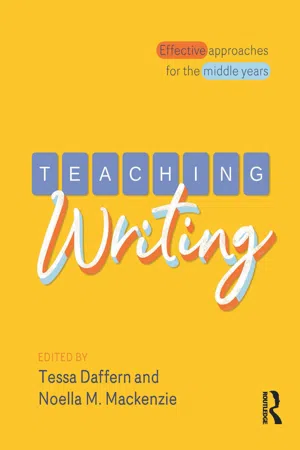
Teaching Writing
Effective approaches for the middle years
- 352 pages
- English
- ePUB (mobile friendly)
- Available on iOS & Android
About This Book
In the 21st century, writing is more important than at any other time in human history. Yet much of the emphasis in schooling has been on reading, and after the early years, writing skills have been given less attention. Internationally, too many children are leaving school without the writing skills they need to succeed in life. The evidence indicates that students rarely develop proficiency as writers without effective teacher instruction. Teaching Writing offers a comprehensive approach for the middle years of schooling, when the groundwork should be laid for the demanding writing tasks of senior school and the workplace. Teaching Writing outlines evidence-based principles of writing instruction for upper primary students and young adolescents. It presents strategies that are ready for adoption or adaptation, and exemplars to assist with designing and implementing writing lessons across the middle years of school. It addresses writing from a multimodal perspective while also highlighting the importance of teaching linguistic aspects of text design such as sentence structure, vocabulary and spelling as foundations for meaning-making. Contributors argue that students need to continue to develop their skills in both handwriting and keyboarding. Examples of the teaching of writing across disciplines are presented through a range of vignettes. Strategies for assessing student writing and for supporting students with diverse needs are also explored. With contributions from leading literacy educators, Teaching Writing is an invaluable resource for primary, secondary and pre-service teachers.
Frequently asked questions
Information
CHAPTER 1
Introduction to teaching writing in the middle years
| Marking criterion | Maximum points | Description |
| Vocabulary | 5 | The range and precision of contextually appropriate language choices. |
| Cohesion | 4 | The control of multiple threads and relationships across the text, achieved through the use of grammatical elements (referring words, text connectives, conjunctions) and lexical elements (substitutions, repetitions, word associations). |
| Sentence structure | 6 | The production of grammatically correct, structurally sound and meaningful sentences. |
| Punctuation | 5 | The use of correct and appropriate punctuation to aid the reading of the text. |
| Spelling | 6 | The accuracy of spelling and the difficulty of the words used. |
| Criterion specific to narrative text type | Maximum points | Description |
| Audience | 6 | The writer's capacity to orient, engage and affect the reader. |
| Text structure | 4 | The organisation of narrative features including orientation, complication and resolution into an appropriate and effective text structure. |
| Paragraphing | 2 | The segmenting of text into paragraphs that assists the reader to negotiate the narrative. |
| Ideas | 5 | The creation, selection and crafting of ideas for a narrative. |
| Character and setting | 4 | The portrayal and development of character; the development of a sense of place, time and atmosphere. |
| Criterion specific to persuasive text type | Maximum points | Description |
| Audience | 6 | The writer's capacity to orient, engage and persuade the reader. |
| Text structure | 4 | The organisation of the structural components of a persuasive text (introduction, body and conclusion) into an appropriate and effective text structure. |
| Criterion specific topersuasive text type | Maximum points | Description |
| Paragraphing | 3 | The segmenting of text into paragraphs that assists the reader to follow the line of argument. |
| Ideas | 5 | The selection, relevance and elaboration of ideas for a persuasive argument. |
| Persuasive devices | 4 | The use of a range of persuasive devices to enhance the writer's position and persuade the reader. |



Table of contents
- Cover
- Title Page
- Copyright Page
- Acknowledgements
- Contents
- Contributors
- Tables and figures
- Glossary
- 1 Introduction to teaching writing in the middle years
- 2 Theoretical perspectives and strategies for teaching and learning writing
- 3 Teachers as writers
- 4 What is involved in the learning and teaching of writing?
- 5 Supporting meaning-making through text organisation
- 6 Supporting meaning-making through sentence structure and punctuation
- 7 Supporting meaning-making through vocabulary
- 8 Supporting meaning-making through handwriting and keyboarding
- 9 Supporting meaning-making through spelling
- 10 How multimodal text changes the pedagogy of writing
- 11 Supporting EAL/D and Indigenous writers
- 12 Teaching writing across disciplines: The upper primary school years
- 13 Teaching writing across disciplines: The early secondary school years
- 14 Cultivating inclusive writing communities
- 15 Assessing writing: Teacher-led approaches
- 16 Assessing writing: Student-led approaches
- Appendix Graphic organisers and assessment templates
- Index